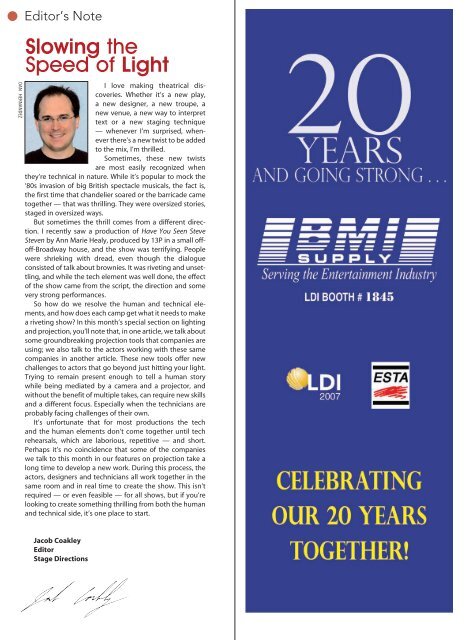Download a PDF - Stage Directions Magazine
Download a PDF - Stage Directions Magazine
Download a PDF - Stage Directions Magazine
Create successful ePaper yourself
Turn your PDF publications into a flip-book with our unique Google optimized e-Paper software.
Dan Hernandez<br />
Editor’s Note<br />
Slowing the<br />
Speed of Light<br />
I love making theatrical discoveries.<br />
Whether it’s a new play,<br />
a new designer, a new troupe, a<br />
new venue, a new way to interpret<br />
text or a new staging technique<br />
— whenever I’m surprised, whenever<br />
there’s a new twist to be added<br />
to the mix, I’m thrilled.<br />
Sometimes, these new twists<br />
are most easily recognized when<br />
they’re technical in nature. While it’s popular to mock the<br />
‘80s invasion of big British spectacle musicals, the fact is,<br />
the first time that chandelier soared or the barricade came<br />
together — that was thrilling. They were oversized stories,<br />
staged in oversized ways.<br />
But sometimes the thrill comes from a different direction.<br />
I recently saw a production of Have You Seen Steve<br />
Steven by Ann Marie Healy, produced by 13P in a small offoff-Broadway<br />
house, and the show was terrifying. People<br />
were shrieking with dread, even though the dialogue<br />
consisted of talk about brownies. It was riveting and unsettling,<br />
and while the tech element was well done, the effect<br />
of the show came from the script, the direction and some<br />
very strong performances.<br />
So how do we resolve the human and technical elements,<br />
and how does each camp get what it needs to make<br />
a riveting show? In this month’s special section on lighting<br />
and projection, you’ll note that, in one article, we talk about<br />
some groundbreaking projection tools that companies are<br />
using; we also talk to the actors working with these same<br />
companies in another article. These new tools offer new<br />
challenges to actors that go beyond just hitting your light.<br />
Trying to remain present enough to tell a human story<br />
while being mediated by a camera and a projector, and<br />
without the benefit of multiple takes, can require new skills<br />
and a different focus. Especially when the technicians are<br />
probably facing challenges of their own.<br />
It’s unfortunate that for most productions the tech<br />
and the human elements don’t come together until tech<br />
rehearsals, which are laborious, repetitive — and short.<br />
Perhaps it’s no coincidence that some of the companies<br />
we talk to this month in our features on projection take a<br />
long time to develop a new work. During this process, the<br />
actors, designers and technicians all work together in the<br />
same room and in real time to create the show. This isn’t<br />
required — or even feasible — for all shows, but if you’re<br />
looking to create something thrilling from both the human<br />
and technical side, it’s one place to start.<br />
Jacob Coakley<br />
Editor<br />
<strong>Stage</strong> <strong>Directions</strong>

















